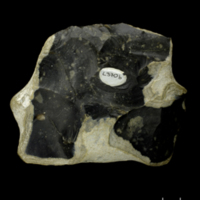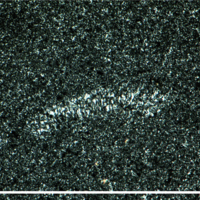- Home
- Rocks
- Type fossils
- Fossil Specimens
- Minerals
- Glossary
- Stratigraphic Chart
- Michel-Levy Chart
- Classification of igneous rocks
- University of Cambridge
- Department of Earth Sciences
- ESC Library
- Moodle
- Sedgwick Museum
- DoITPoMS
- Mindat.org
- Microfossils
- Bryozoans
- Webmineral
- Tree of Life
- CrystalMaker
- Virtual Microscope
L370 - Flint nodule (chert)
Age
Cretaceous
Location
Upper Chalk, Cambridgeshire
Hand Specimen
This rock is made up of cryptocrystalline silica (quartz), black to brown. Being made up of silica, it is hard and displays conchoidal fracture.
This is a flint nodule, which comes from a chalk bed – notice the thin shell of white chalk. Flints are irregular silica concretions characteristic of the upper Chalk.
Thin-section
Cryptocrystalline silica (quartz)
Amorphous, not grains. Partially devitrified
Uniform texture
Rare larger quartz crystals
Occasional elliptical strips of greater than average grain size probably represent cross-sections of shells now replaced by silica.
Rock History
Flint nodules are produced by the digenetic replacement of chalk. A silica gel, formed by the dissolution of sponge spicules, precipitates silica in nodules. Chert deposits are more common in organic-rich regions of the chalk, and there is a hypothesis that the silica precipitates in burrows.
Rock Name
chert
flint nodule
flint nodule



